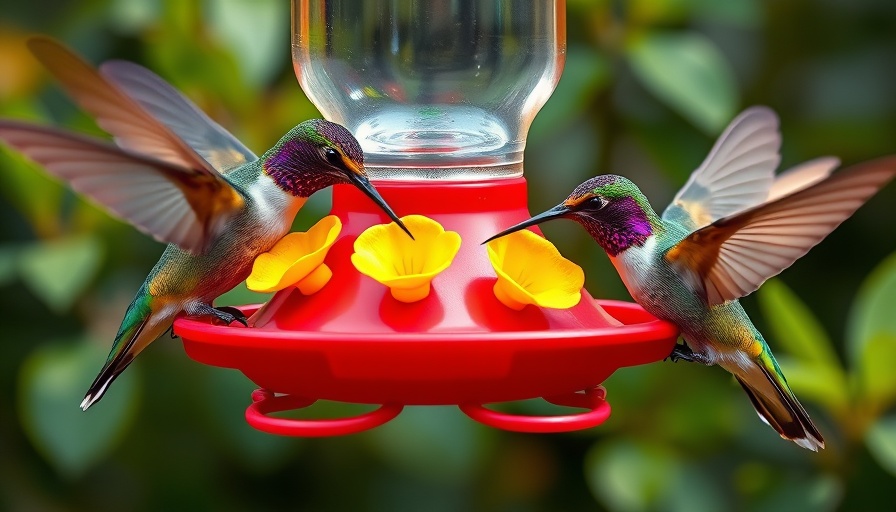
Discovering Hummingbird Migration Patterns: What You Need to Know
As spring returns, so do the hummingbirds, those delightful tiny birds that flit about, bringing joy to many. For birdwatchers and gardening enthusiasts alike, understanding when these colorful creatures will arrive in your area is vital. With the interactive migration map created by Hummingbird Central, anyone can track their journey as they migrate from their winter homes in Central America and Mexico back to the northern United States.
Why Track Hummingbirds?
The attraction of hummingbirds isn't just their vibrant colors and entertaining acrobatics; it lies in their ecological importance. These birds are pollinators for various plants and are vital for maintaining the health of many ecosystems. As such, tracking their migratory patterns offers not only anticipatory joy for birdwatchers but also insight into the health of our environments. The interactive map offered by Hummingbird Central uses data from avid birdwatchers across the country, making it a community-driven effort to monitor these tiny aviators' movements effectively.
An Interactive Tool for Bird Enthusiasts
The Hummingbird Central map is a cutting-edge resource, showcasing real-time sightings and migration patterns. Users can check daily updates to see where hummingbirds have been spotted, providing an easy way to know when these birds are nearing your area. Each sighting contributes to the broader understanding of hummingbird behavior and migration trends, which can fluctuate significantly year to year based on environmental factors.
Types of Hummingbirds to Look Out For
The interactive map also includes detailed information about various hummingbird species, from the common ruby-throated to the distinctive black-chinned hummingbirds. For those eager to enhance their birdwatching experience, understanding which species are prevalent in your area can inform your gardening decisions.
For instance, ruby-throated hummingbirds are the most frequently sighted species in the eastern United States. However, certain regions may play host to a variety of others, such as the Anna’s hummingbird or Calliope hummingbirds, each attracted to different types of flowers. Tailoring your garden with appropriate flora, like salvia or trumpet vines, can make your yard a haven for these avian visitors.
Enhancing Your Garden for Hummingbirds
To attract hummingbirds, it's crucial to create a welcoming environment. Consider incorporating bird baths or sugar-water feeders. The sugar-water feeder allows you to provide an easily accessible food source that can entice these birds to visit while they are migrating. It is a simple yet effective way to ensure they stop by your yard on their journey.
Community Engagement and Contribution
One of the most rewarding aspects of using the Hummingbird Central map is the opportunity to be part of a larger community. When you spot a hummingbird, you can submit your sighting to contribute to the ongoing tracking efforts. This feedback loop helps refine the accuracy of the interactive map, thus benefiting everyone in the birdwatching community.
A Look Ahead: Future of Hummingbird Observations
The future of birdwatching looks promising with the ever-growing presence of technology in the tracking and conservation of wildlife. Animations and data visualizations based on past sightings provide an educated guess on future migration patterns, empowering enthusiasts to anticipate arrivals more closely. By planning ahead, you can ensure your garden is ready to welcome hummingbirds as they arrive.
As we embrace this technological advancement, the fusion of community input and real-time data updates paves the way for meaningful citizen science initiatives. Engaging with the environment through birdwatching not only promotes outdoor activity but fosters appreciation for wildlife and conservation efforts.
Why It Matters for Local Communities
Tracking the migration of hummingbirds can have profound effects on local communities. Understanding their patterns can lead to better gardening practices, support local ecosystems, and enhance community engagement through shared interests in wildlife. As hummingbird populations fluctuate, they serve as indicators of environmental health, signaling to gardeners and everyone involved the state of our natural landscapes.
So, whether you’re a seasoned birdwatcher or just getting started, utilize the Hummingbird Central map as a valuable resource. Get involved, attract these magnificent birds, and enjoy watching nature’s wonders unfold right in your backyard!
 Add Row
Add Row  Add
Add 




 Add Row
Add Row  Add
Add 


Write A Comment